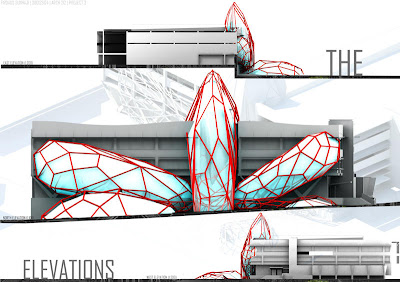One of RMIT school project, Design Studio 5, (semester 1, 2009) by
Afiq Shazwan. What I like about this project is the uniqueness of the way the panels are presented. Afiq Shazwan confidently used simple line drawing not only for plans and sections but also in perspective drawings.
Studio : Architectural Knowledge
Project : Small scale addition to residential buildings
Tutor : Louise Wright
Architecture School: Royal Melbourne Institute of Technology (RMIT)
INTRO
This studio is my last studio for my lower pool studies. The workload is not that heavy. In fact my tutor, Louise Wright was quite easy going when it comes to doing work. Anyway, going straight to the point.
This studio is about designing an addition to an existing residential house, using our built up architectural knowledge. What is architectural knowledge? They are, really, just some concepts and ideas of spaces (the perception of spaces by man). For example:
- a small space will feel bigger when we have high ceilings
- people's view will be forced out to the windows/outside when they are in spaces with low ceilings
DESIGN PROJECT
My site is in 5 Crampton Crescent, Rosanna. It is a quiet residential area, with a little bit of slope. It is a post WW2 brick veneer house, therefore it has quite a large backyard. In my design, I tried not to change to much of the original house, therefore the renovation will only be 'add-ons' to the existing.


In a lot of the case studies, there are a lot of strategies that has been used to bring in some natural element in the house. Therefore, in my design, I have tried to do the same.
The existing house has 2 bedrooms. However, I needed an extra bedroom to meet the design requirement issued by the tutor, therefore I played with the configuration of spaces inside, trying to squeeze in the extra bedroom within the existing plan. That results in the bedroom being quite small. Therefore, I 'removed' the exisiting windows, leaving the walls with an empty hole, and then added walls outside, 800mm from the existing walls. This makes the space feels bigger.

The existing house also has planter beds with vegetations all around the house, following the boundary set by the fence. Therefore, I continued the language inside the house by having vegetations (shrubs) in the layer between the existing walls and new walls. Since the new walls wraps around part of the house, so is the layer of shrubs. In terms of spatial quality, I think it enhance the interior spaces. That is a personal opinion which some might agree and some might not. But generally, a lot of people like vegetations. So that is the basic idea behind it.
I always thought that it would be great if our homes are open to the garden/nature/etc.. Again this is a personal interest and opinion, and might vary from others.
In the existing house, there was no direct relationship between the interior and exterior spaces. Therefore, as part of the renovation process, I've decided to open up the kitchen to the backyard, and tried to blur the transition between inside and outside, like what was done by Geoffrey Bawa in his projects. What I did was extending the roof, ceiling, one side wall, and the floor to the corner of the backyard. So when people stand there at the extended elements, they will feel like they are inside the house (because of the ceiling above them, the floors that they stand on, the walls that they see), but at the same time, they are also outside because they are already in the backyard and can engage directly with the weather. If its winter, they will feel cold, if its summer, they will feel the heat, if its raining, they will feel the rain. You get what I mean.


Studying Bawa's work, I realized that it would be better, in terms of landscape design, to have a direct view relationship between the space we are in, and the space that our eyes see. Sounds weird. Basically, when you are standing at point A, you would be able to see an object (landscape element) in front of you. For example, a tree, or a large boulder, or a fountain, etc..
That was part of the knowledge that has been brought into this project but I think that is sufficient to sum up this semester's work, as brief as possible. The followings are my presentation panels and some pictures of the cardboard model (thank you
ar-fira for the excellent photographs).
 © Afiq Shazwan
© Afiq Shazwan













































